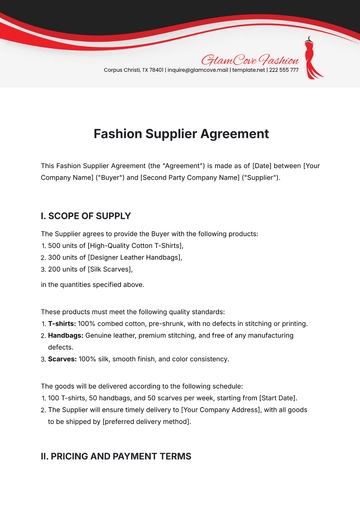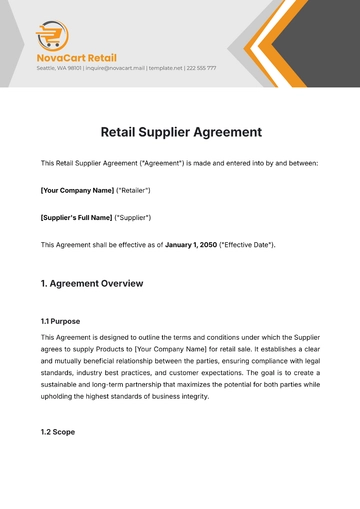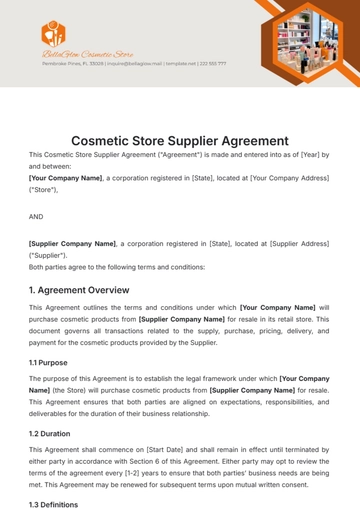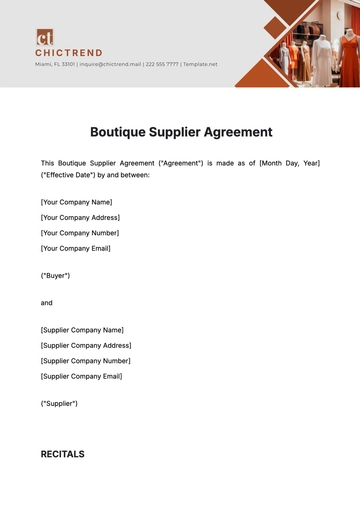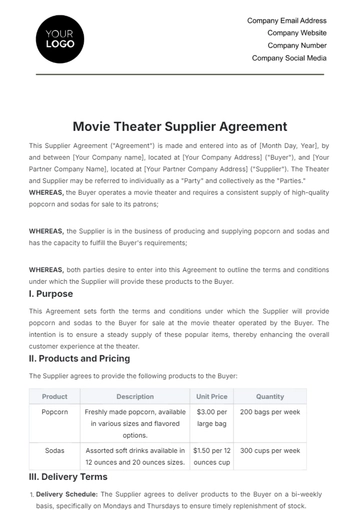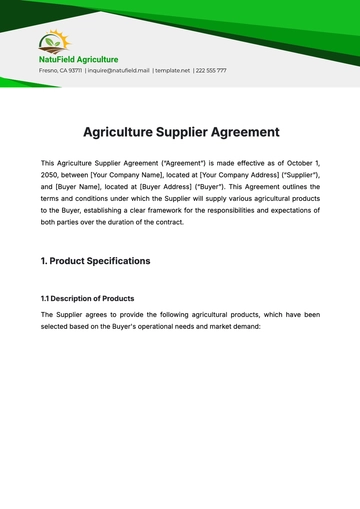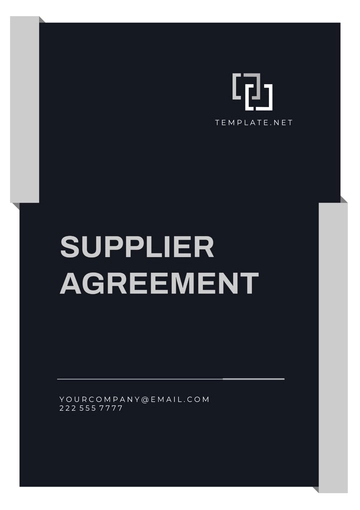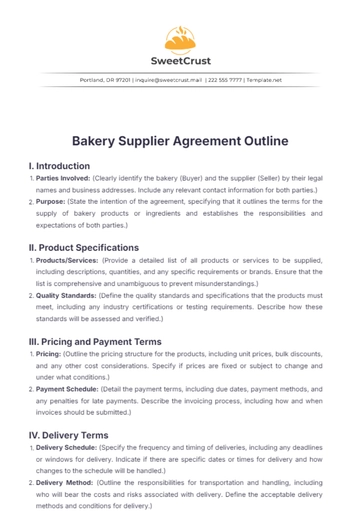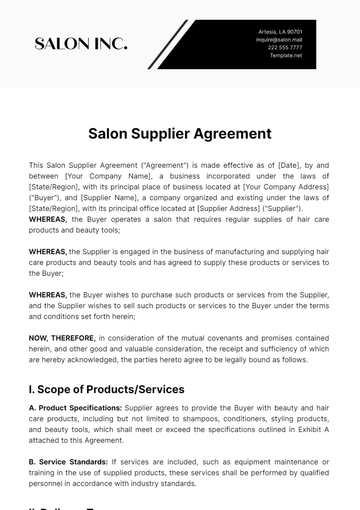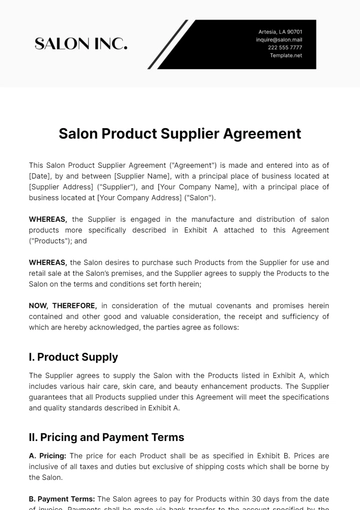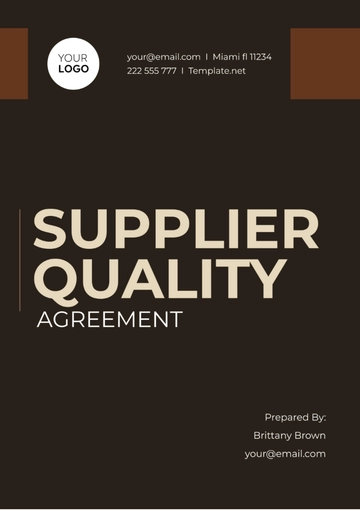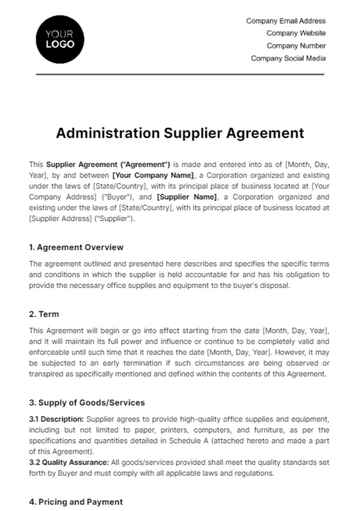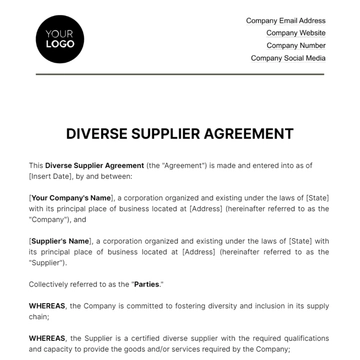Free Bakery Supplier Agreement Outline
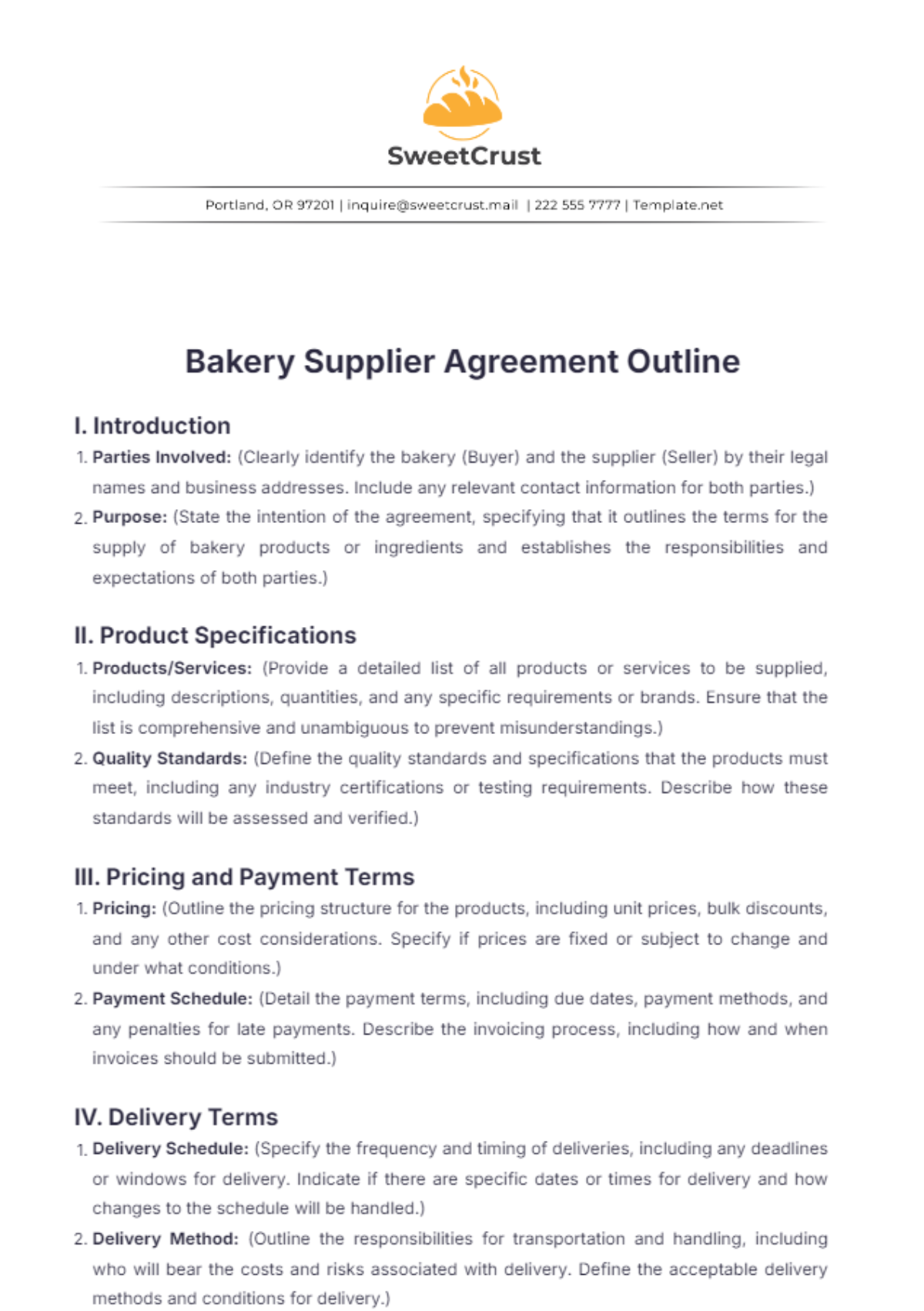
I. Introduction
Parties Involved: (Clearly identify the bakery (Buyer) and the supplier (Seller) by their legal names and business addresses. Include any relevant contact information for both parties.)
Purpose: (State the intention of the agreement, specifying that it outlines the terms for the supply of bakery products or ingredients and establishes the responsibilities and expectations of both parties.)
II. Product Specifications
Products/Services: (Provide a detailed list of all products or services to be supplied, including descriptions, quantities, and any specific requirements or brands. Ensure that the list is comprehensive and unambiguous to prevent misunderstandings.)
Quality Standards: (Define the quality standards and specifications that the products must meet, including any industry certifications or testing requirements. Describe how these standards will be assessed and verified.)
III. Pricing and Payment Terms
Pricing: (Outline the pricing structure for the products, including unit prices, bulk discounts, and any other cost considerations. Specify if prices are fixed or subject to change and under what conditions.)
Payment Schedule: (Detail the payment terms, including due dates, payment methods, and any penalties for late payments. Describe the invoicing process, including how and when invoices should be submitted.)
IV. Delivery Terms
Delivery Schedule: (Specify the frequency and timing of deliveries, including any deadlines or windows for delivery. Indicate if there are specific dates or times for delivery and how changes to the schedule will be handled.)
Delivery Method: (Outline the responsibilities for transportation and handling, including who will bear the costs and risks associated with delivery. Define the acceptable delivery methods and conditions for delivery.)
V. Quality Control and Inspection
Inspection Rights: (State the rights of the bakery to inspect the products upon delivery and the procedures for doing so. Include provisions for rejecting products that do not meet the agreed-upon specifications.)
Standards Compliance: (Describe the compliance requirements for products with relevant quality and safety standards. Outline the steps to be taken if products fail to meet these standards, including corrective actions.)
VI. Duration and Termination
Contract Term: (Specify the start and end dates of the agreement, and any provisions for extending or renewing the contract. Include details on how the agreement may be amended or extended.)
Termination: (Define the grounds for early termination, including any required notice periods and procedures. Address the consequences of termination, such as the handling of outstanding payments or obligations.)
VII. Confidentiality
Confidential Information: (Define what constitutes confidential information and the obligations of both parties to protect such information. Include provisions for handling and safeguarding confidential data.)
Non-Disclosure Obligations: (Specify the terms under which confidential information must not be disclosed to third parties. Describe the duration of confidentiality obligations and any exceptions.)
VIII. Liability and Indemnification
Liability: (Outline the extent of liability for each party, including limitations on damages or claims. Specify any exclusions or caps on liability to manage potential risks.)
Indemnification: (Describe the indemnification obligations, including how each party will cover damages or losses resulting from breaches or other issues. Include the procedures for making indemnification claims.)
IX. Dispute Resolution
Dispute Resolution Method: (Specify the method for resolving disputes, such as mediation, arbitration, or litigation. Include the steps to be followed in the event of a dispute and the timeline for resolution.)
Governing Law: (State the jurisdiction and legal framework that will govern the agreement. Include details on which laws will apply and where any legal proceedings should take place.)
X. Miscellaneous
Amendments: (Detail the process for making changes to the agreement, including how amendments must be documented and agreed upon by both parties. Describe any required formalities for amendments.)
Entire Agreement: (Include a clause stating that the written agreement constitutes the entire understanding between the parties and supersedes any prior agreements or understandings.)
Signatures: (Provide space for the signatures of authorized representatives from both the bakery and the supplier, along with their titles and dates. This section formalizes the agreement and confirms mutual consent.)
- 100% Customizable, free editor
- Access 1 Million+ Templates, photo’s & graphics
- Download or share as a template
- Click and replace photos, graphics, text, backgrounds
- Resize, crop, AI write & more
- Access advanced editor
Introducing the Bakery Supplier Agreement Outline Template from Template.net, your go-to resource for a streamlined contract creation process. This editable and customizable template ensures that every detail is tailored to your needs. Leverage the power of the AI Editor Tool to effortlessly refine and perfect your agreement, making it a breeze to achieve precise, professional results.
You may also like
- Lease Agreement
- Non Compete Agreement
- Rental Agreement
- Prenuptial Agreement
- Non Disclosure Agreement
- Operating Agreement
- Hold Harmless Agreement
- LLC Operating Agreement
- Arbitration Agreement
- Purchase Agreement
- Residential Lease Agreement
- Executive Agreement
- Confidentiality Agreement
- Contractor Agreement
- Partnership Agreement
- Postnuptial Agreement
- Collective Bargaining Agreement
- Loan Agreement
- Roommate Agreement
- Commercial Lease Agreement
- Separation Agreement
- Cohabitation Agreement
- Room Rental Agreement
- Child Custody Agreement
- Employee Agreement
- License Agreements
- Settlement Agreement
- Joint Venture Agreement
- Indemnity Agreement
- Subordination Agreement
- Sales Agreement
- Agreements Between Two Parties
- Business Agreement
- Real Estate Agreement
- HR Agreement
- Service Agreement
- Property Agreement
- Agreement Letter
- Restaurant Agreement
- Construction Agreement
- Finance Agreement
- Marketing Agreement
- Payment Agreement
- Investment Agreement
- Management Agreement
- Nonprofit Agreement
- Software Agreement
- Startup Agreement
- Agency Agreement
- Copyright Agreement
- Collaboration Agreement
- Reseller Agreement
- Car Rental Agreement
- Cleaning Services Agreement
- Consultant Agreement
- Deed Agreement
- Car Agreement
- Equipment Agreement
- Shares Agreement
- Data Sharing Agreement
- Advertising Agreement
- School Agreement
- Franchise Agreement
- Event Agreement
- Travel Agency Agreement
- Vehicle Agreement
- Board Resolution Agreement
- Land Agreement
- Binding Agreement
- Tenancy Agreement
- Exclusive Agreement
- Development Agreement
- Assignment Agreement
- Design Agreement
- Equity Agreement
- Mortgage Agreement
- Purchase and Sale Agreement
- Shareholder Agreement
- Vendor Agreement
- Royalty Agreement
- Vehicle Lease Agreement
- Hotel Agreement
- Tenant Agreement
- Artist Agreement
- Commission Agreement
- Consignment Agreement
- Debt Agreement
- Recruitment Agreement
- Training Agreement
- Transfer Agreement
- Apprenticeship Agreement
- IT and Software Agreement
- Referral Agreement
- Resolution Agreement
- Waiver Agreement
- Consent Agreement
- Partner Agreement
- Social Media Agreement
- Customer Agreement
- Credit Agreement
- Supply Agreement
- Agent Agreement
- Brand Agreement
- Law Firm Agreement
- Maintenance Agreement
- Mutual Agreement
- Retail Agreement
- Deposit Agreement
- Land Purchase Agreement
- Nursing Home Agreement
- Supplier Agreement
- Buy Sell Agreement
- Child Support Agreement
- Landlord Agreement
- Payment Plan Agreement
- Release Agreement
- Research Agreement
- Sponsorship Agreement
- Buyout Agreement
- Equipment Rental Agreement
- Farm Agreement
- Manufacturing Agreement
- Strategic Agreement
- Termination of Lease Agreement
- Compliance Agreement
- Family Agreement
- Interior Design Agreement
- Ownership Agreement
- Residential Lease Agreement
- Retainer Agreement
- Trade Agreement
- University Agreement
- Broker Agreement
- Dissolution Agreement
- Funding Agreement
- Hosting Agreement
- Investor Agreement
- Memorandum of Agreement
- Advisory Agreement
- Affiliate Agreement
- Freelancer Agreement
- Grant Agreement
- Master Service Agreement
- Parking Agreement
- Subscription Agreement
- Trust Agreement
- Cancellation Agreement
- Horse Agreement
- Influencer Agreement
- Membership Agreement
- Vacation Rental Agreement
- Wholesale Agreement
- Author Agreement
- Distributor Agreement
- Exchange Agreement
- Food Agreement
- Guarantee Agreement
- Installment Agreement
- Internship Agreement
- Music Agreement
- Severance Agreement
- Software Development Agreement
- Storage Agreement
- Facility Agreement
- Intercompany Agreement
- Lending Agreement
- Lodger Agreement
- Outsourcing Services Agreement
- Usage Agreement
- Assurance Agreement
- Photography Agreement
- Profit Sharing Agreement
- Relationship Agreement
- Rent To Own Agreement
- Repayment Agreement
- Volunteer Agreement
- Co Parenting Agreement
- HVAC Agreement
- Lawn Care Agreement
- SAAS Agreement
- Work from Home Agreement
- Coaching Agreement
- Protection Agreement
- Security Agreement
- Repair Agreement
- Agreements License
